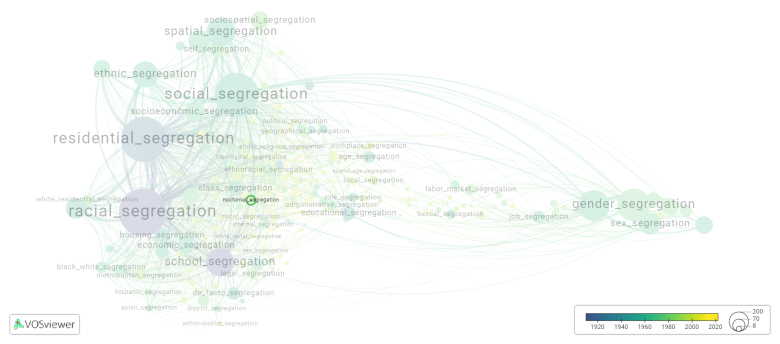Nocturnal segregation: Difference between revisions
(Creating page) |
(Creating page) |
||
| (3 intermediate revisions by the same user not shown) | |||
| Line 16: | Line 16: | ||
Understanding nocturnal segregation is crucial for studying and conserving biodiversity. It reveals the complex interactions and adaptations among nocturnal animals and helps in developing effective conservation strategies to protect these species and their ecosystems. | Understanding nocturnal segregation is crucial for studying and conserving biodiversity. It reveals the complex interactions and adaptations among nocturnal animals and helps in developing effective conservation strategies to protect these species and their ecosystems. | ||
==See also== | ==See also== | ||
==Related segregation forms== | |||
Nocturnal segregation is frequently discussed in the literature with the following segregation forms: | |||
[[residential segregation]], [[racial residential segregation]], [[racial segregation]] | |||
[[File:nocturnal_segregation.png|780x780px]] | |||
This visualization is based on the study [[Segregation_Wiki:About| The Multidisciplinary Landscape of Segregation Research]]. | |||
For the complete network of interrelated segregation forms, please refer to: | |||
* [https://tinyurl.com/2235lkhw First year of publication] | |||
* [https://tinyurl.com/2d8wg5n3 Louvain clusters] | |||
* [https://tinyurl.com/223udk5r Betweenness centrality] | |||
* [https://tinyurl.com/244d8unz Disciplines in which segregation forms first emerged (Scopus database).] | |||
==References== | ==References== | ||
==Notes== | ==Notes== | ||
Latest revision as of 07:17, 16 October 2024
Date and country of first publication[1][edit | edit source]
1988
United States
Definition[edit | edit source]
Nocturnal segregation refers to the phenomenon where species separate or segregate their activities based on the time of day. This occurs primarily in animal species that are active during the night, known as nocturnal animals.
Nocturnal segregation can happen in different ways. One way is through temporal partitioning, where different species utilize different portions of the night for their activities. For example, some nocturnal animals may be more active during the early night, while others are more active during the late night or early morning.
Another form of nocturnal segregation is spatial partitioning, where different species occupy different areas or habitats within their environment. Each species may have specific requirements or preferences for their nesting sites, foraging areas, or resting spots, resulting in spatial separation during the night.
Nocturnal segregation can serve various purposes, including reducing competition for food, minimizing the risk of predation, or maximizing resource availability. It allows different species to coexist and utilize available resources more efficiently.
Examples of nocturnal segregation can be seen in many ecosystems. For instance, different bat species may segregate their foraging activities by utilizing different feeding grounds or different prey items. Nocturnal birds, such as owls, may segregate their habitats by occupying various tree cavities or using specific hunting techniques.
Understanding nocturnal segregation is crucial for studying and conserving biodiversity. It reveals the complex interactions and adaptations among nocturnal animals and helps in developing effective conservation strategies to protect these species and their ecosystems.
See also[edit | edit source]
Related segregation forms[edit | edit source]
Nocturnal segregation is frequently discussed in the literature with the following segregation forms:
residential segregation, racial residential segregation, racial segregation

This visualization is based on the study The Multidisciplinary Landscape of Segregation Research.
For the complete network of interrelated segregation forms, please refer to:
References[edit | edit source]
Notes[edit | edit source]
- ↑ Date and country of first publication as informed by the Scopus database (December 2023).
At its current state, this definition has been generated by a Large Language Model (LLM) so far without review by an independent researcher or a member of the curating team of segregation experts that keep the Segregation Wiki online. While we strive for accuracy, we cannot guarantee its reliability, completeness and timeliness. Please use this content with caution and verify information as needed. Also, feel free to improve on the definition as you see fit, including the use of references and other informational resources. We value your input in enhancing the quality and accuracy of the definitions of segregation forms collectively offered in the Segregation Wiki ©.
Nocturnal segregation appears in the following literature[edit | edit source]
Frenkel S., Western J. (1988). Pretext or Prophylaxis? Racial Segregation and Malarial Mosquitos in a British Tropical Colony: Sierra Leone. Annals of the Association of American Geographers, 78(2), 211-228. https://doi.org/10.1111/j.1467-8306.1988.tb00203.x
